A.C. Ping's Blog
January 27, 2016
Awake? Now what?

“At the end of all our journeying we shall return to the place from which we started and know it for the first time.”
(T.S. Elliot – on the paradox of enlightenment)
Having survived the turmoil of the last three years which began with the 2012 challenge, you may now be reading this with a new sense of enlightenment. However, just like a martial arts student doesn’t really know how to walk until they achieve a black belt level, you may also now be asking what should you do with this new sense of awareness.
As your focus shifts from “Me and mine” to “Us and ours” a quick look around the horizon reveals four significant challenges to our shared journey of ascension. One – the risk that we destroy the very environment that supports us through man made climate change. Two – the rapidly widening gap between the rich and the poor. Three – the increased levels of violence and global terrorism. Four – the security responses to this that are taking away our freedoms and civil rights leaving us watched by ‘big brother’ at every turn.
At the root of these four issues is fear in its many different forms and at the heart of the solution to all of these challenges is love. Cliché, I know, but hear me out – fear drives the justifications that rationalise away our guilt and allow us to do little about these issues without having to reassess ourselves as ‘bad’. So it is here at this junction point of creation that we must pause and use our new found powers of mindfulness to deconstruct our thinking and view the problems afresh.
Fundamentally, we are faced with systems problems. Our economic system is carbon based hence we keep digging up coal and oil, burning it and pumping it into the atmosphere. Similarly, our financial system is utilitarian based hence we keep rewarding outcomes based on money not principles. Fear then feeds separation, judgement, scarcity, us and them type thinking and the ultimate manifestation is violence and the violation of the sanctity of life itself.
Awareness of the temporal nature of existence and the critical relationship between being and time reveals disconnects between what we aspire to create, what we actually create and how we justify why we did what we did – or didn’t do. A lot to take in I know so let’s break it down and delve into the weird and wonderful world of social constructivism. Social constructivism says that there is no objective reality but rather reality is created by the actors themselves through the stories they tell.
So, we might aspire to create a world of peace and harmony but when confronted with the current challenges it is all too easy to see them as all too hard and beyond the influence of someone as insignificant as us. A cold hard objective look would be far too depressing and the self-analysis and judgement too severe and harsh. Enter some justifications to get ourselves off the hook:- It’s not my responsibility – I’m insignificant and have no power so there’s nothing I can do about it; It’s not hurting anyone – out of sight, out of mind; They deserved it; If you think I’m bad you should see them; I did it for you, for family, for God; Everyone else is doing it so I had no choice but to follow suit; and finally, I deserve it – I’ve worked hard and paid my price.
It’s these types of justifications that you need to be mindful of as you learn to walk with your new black belt. If you’re aware it’s a systems problem then there are things you can actually do. The carbon based economy is on the way out – there’s a reason major mining companies are divesting their coal assets. Your power lies in how you interact with the financial system – how you earn, spend and invest your money. The key here is existential alignment – that is to be able to align what you aspire to create with your actions in the present moment and the story that you tell to be able to justify what you actually did. Easy eh?
Problem is there’s theory and then there’s reality – for example, you aspire to be environmentally friendly and contribute to creating a world where your children get to enjoy what you have enjoyed. You want them to have a good life so you’ve built a house and have a healthy sized mortgage, but then the company you work for makes you redundant and the best option is working in the mines on a fly in, fly out basis. It’s easy to justify this despite the conflict because you’re doing it for your kids and if you don’t do it someone else will. But you’re not aligned, there’s an internal conflict so here’s where love comes in and a healthy dose of faith.
There are two distinct paths one can go down here – buy into the fear, keep doing what you’re doing and justify away your guilt; or be mindful of the conflict, refuse the job on the basis of principle, step into the realm of faith and make a conscious choice to love yourself regardless of the consequences…
Nobody said it was easy…
Faith is a belief in something for which there is no evidence. Awareness, awakens you to possibility but not certainty. Now you’re awake take the time to consider what you will and will not put energy into, become aware of the flawed justifications that will inhibit your ability to actually do this. Work on aligning yourself existentially, but most of all make a conscious choice to love yourself unconditionally and have faith in the shared ascension of us all.
In peace and love always :)
August 23, 2015
Vision Quest Time

Coming into the Equinox - Sept 23rd - is traditionally the time of the year to refresh and renew your Vision this is because the energies of the cosmos are in equal balance - equal day equal night - hence equinox.
If you are in the Southern Hemisphere you are about to go into a period of about three months through to the summer solstice where the days are getting longer and longer. This means that the expansive energy of the sun is getting greater and greater. If you are in the Northern Hemisphere the opposite is occurring with the introspective energy of the Moon getting stronger and stronger up until the winter solstice.
This has implications for visioning - if you are entering an expansive period you need you be more orientated to DOing and getting stuff out there. If you are entering the introspective phase you need to be more orientated to BEing and getting your internal house in order.
Having said all that the question is how to do it...
Traditionally and ideally you should do some prep work over the next four weeks or so and then take yourself off to the mountains and sit in circle for up to 4 days and ask for spiritual guidance for your Vision. This can be hard to do if you live in a city and/or have ongoing commitments however you can do the prep work and plant some seeds.
As a possibility I suggest this 28 day reflective process which you can start this Friday.
For five days each consider the 5 areas of Vision in this order - Spiritual, Emotional, Physical, Mental, Material.
For the first four days - PLAY (engage the wondering mind) - ask the questions - What do I want and what does this look like and feel like? I'd suggest focusing on a one year time frame - so for example - sit quietly and imagine it's Sept 2016 - What do you want spiritually? What does this look like? that is - What are you actually DOing? and What does this feel like? Remember here to focus on essence not form. Play with it here - put the question out there and allow it to come to you - be receptive in your dreams and in your everyday life. A good question to ask is 'I wonder what would happen if...?'
Use what you need to make it real - write, draw, paint etc
On the fifth day - ask - What do I need to let go of to allow this to happen? Write these answers on separate pieces of paper (you'll see why in a sec).
Then on day 6 do the same with Emotional for 5 days then Physical, Mental and so on until on the 20th Sept you will be finishing Material. Also if you are inspired to incorporate directions - this relates to the Medicine Wheel - you will be going East (Spirit), South (Emotional), West (Physical), North (Mental), Earth (Material).
Monday 21st Sept is the day to bring it all together and return to Spirit (East) to receive the new. Start by putting all your Visioning bits together - again allow yourself to synthesize the bits into a whole.
Next take all the bits of paper on which you have written all of the things you wish to let go of. Light a fire - or if not possible a candle (remember to unplug the smoke alarms...) - take each piece of paper in the order you wrote them - read them out loud and say "I release this past behaviour/pain/fear/memory/relationship (which ever is appropriate) to the universe and allow the energy to be transformed for the highest good" - then burn them.
Last bit - on the day of the Equinox - if you can go and sit somewhere quiet or take time out in some way that's great - if not light a candle and put some of your favourite things/crystals/photos (esp. of ancestors). Put your consolidated Visioning writings/drawings/paintings etc with your candle - if it is in a book make sure it is open - and ask for assistance and guidance to bring it into creation. Big key here is to be open - don't assume you know - allow intuition, spirit, prayer, insight to guide and inform you. Hold your intention to stay in that space for the whole day - be aware of nature, especially animals, birds etc. Take special note of your dreams that night.
On awakening say thank you remembering that Grace is the unearned love of God (Universal Spirit)
In peace and love always :)
April 20, 2015
The Art of Remembering Who You Really Are
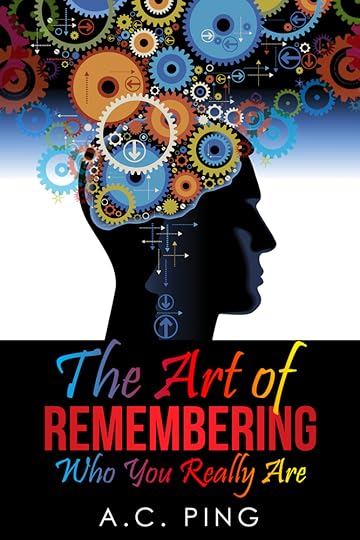
Now available on Amazon Kindle FREE for the next 3 days April 21-23
April 9, 2015
A Treatise on Anger
“Anger is a wind which blows out the lamp of the mind.”
Robert Green Ingersoll
We should banish the world of anger – expel it to the farthest reaches of the Universe – prohibit all and every person from being or becoming angry – especially men. It is a toxic emotion that serves no purpose except to incite war and death. Way back in Rome at the time of Christ, Lucius Annaeus Seneca (otherwise known as Seneca the younger) knew this when he wrote,
“Anger: an acid that can do more harm to the vessel in which it is stored
than to anything into which it is poured.”
But is this really true?
Aristotle, 350 odd years earlier in Greece wrote,
“Anyone can become angry, that is easy.
But to be angry at the right person, to the right degree,
at the right time, for the right purpose,
and in the right way – that is not easy.”
So, here lies our issue, it is ridiculous to say that any and all forms of anger are bad. We needed it way back in the day when could be set upon by a tiger walking through the jungle. Faced with the choice of death and the fight, flight or freeze response I’m sure most would agree we’d at least like one brave soul to become as outrageously angry as possible – so outrageously angry in fact that they might be foolish enough to actually stand up to the tiger whilst the rest of us bugger off as quickly as our shaking little legs could carry us. So in survival mode sure, bring on the anger and make it as fast and as irrational as possible.
The mechanism here is seated deep in the brain – rational mind gets ‘blown out’ by a little almond shaped part of the brain’s limbic system called the amygdala. Thought processes get hijacked by massive emotional responses. Hence ‘brave’ man doesn’t even think of fear or even consequences, adrenalin and emotions take over – irrationality rules.
Problem is, of course that ‘brave’ becomes ‘dumb’ when ‘tiger’ gets confused with ‘person in car who cuts us off in traffic’. New research, thanks to advances in neuro-cognitive science, also shows us with the benefit of fMRI machines that our ‘self regulatory’ function – yes, that’s the bit that says ‘No dummy that’s not a tiger!’ – is diminished by things such as stress, lack of sleep, lack of caffeine and – bet you might have guessed this one – how fairly we think we are being treated…
Hence, if you are working long hours (see latest research on work trends), are sleeping badly (see the effects on sleep patterns of using more mobile gadgets – and if you sleep with your phone on your bedside table here’s a free tip – STOP IT NOW!), and/or feel like you have been slighted in some way – then guess what? The person in the car who cuts us off looks a lot like a tiger!
Hmmm… But wait there’s more – neuro-cognitive research informs us that we all have what’s called mimic neurons in our brains which means that if we see or experience an angry person, for example, we actually mimic their anger. Neat huh? Anger actually attracts anger – the person in the car who cuts us off in traffic may see us in their rear view mirror giving them the proverbial finger and cussing at them, and guess what – mimic neurons kick in and bingo – tiger sees tiger after all!
Ok – so let’s back up a bit before this all gets out of hand. Lots of beautiful teachings tell us that all anger arises from within. We fear we are going to be eaten by a tiger so we get angry to spur us into action or at some point in our lives some miserable bugger (otherwise known as venerable teacher) hurt us in such a way as to cause us to store such level of emotion to allow us to tap into extreme anger to ensure it never happens to us again. And some of us have been repeatedly hurt in such a way that we have masses of emotional pain stored inside us that we can only access and hopefully release through anger, conflict and a good fight.
The problem is, as you may have gathered from above, that once the genie is out of the bottle – look out! Hijacking begins, we are not in control, we are wild and emotional. So, where lies opportunity? BEFORE the hijacking that’s where. Because as Aristotle says, we would like to be angry in the right way not just be the vehicle holding the poisonous chalice.
Own your anger. Don’t ever blame anyone else for your own anger. Self-awareness is the start – What makes you angry? What happens when you get angry? What happens to your breathing, your thought processes, and your physical body? Recognise what presses your buttons? What is the trigger? – is it self worth, pride, old patterns, past experiences? Recognise the signs and the stages and know that the opportunity to prevent a hijacking occurs only in the beginning stages.
Make a choice to love yourself unconditionally. Make a choice to choose what it is that you actually want in your life. Be clear on what the boundaries are. Become aware of when those boundaries are being crossed. Don’t kid yourself that you can reason with the dummy who thinks they are seeing a tiger and recognise that your very own mimic neurons will undermine your calm response. WALK AWAY.
“Darkness cannot drive out darkness: only light can do that.
Hate cannot drive out hate: only love can do that.”
Martin Luther King Jr.
In peace and love always.
February 3, 2015
Believe in Someone
“Treat a man as he is and he will remain as he is. Treat a man as he can and should be and he will become as he can and should be.”
Goethe
The transition to the new school had been tough for the young boy, not just because of the change from a school where disputes were settled with fists to one where words were preferred, but because of the sudden and overwhelming focus on academic results.
Results spoke even louder than words. Results were revealed for all to see. Students were graded in the minutiae, a list produced in order of performance and then posted on the noticeboard.
In such an environment the boy felt overwhelmed and was quickly placed into a box by the teachers called ‘average’. As an average student he gave average effort and reports during the year more often than not read ‘could try harder’. But why? He was average, his results were average, and so his expectation of self was average.
His main focus was survival. His worst nightmare was Maths, not just because of the maths itself, but because of the maths teacher, a gruff ex military type who chain smoked between classes in the staff common room and who delighted in taunting the boy with a rhyming criticism of his work.
At the completion of his first year at the school the boy was relieved – his results average, his effort average, his expectations of himself average. The long summer holidays gave him ample time to form stronger bonds with his new class mates and to reassess his view of himself. A new year, he told himself, a new teacher, a chance to begin again. But his enthusiasm deflated when on the first day of the new school year he found out that he was to have the same gruff maths teacher – the only difference to the previous year was that now he was not alone, now he had friends who encouraged him to ignore the taunts of the teacher and just get on with things instead.
“I can never be what I ought to be until you are what you ought to be, and you can never be what you ought to be until I am what I ought to be. This is the inter-related structure of reality.”
Martin Luther King Jnr.
Arriving at class for Maths the boy’s stomach was full of butterflies, he walked in with his head down trying to avoid the gaze of the teacher and it was only when he had found his desk and sat down that he looked up. The gruff, heavily built teacher had shrunk, his face was drawn and gaunt and he now sported a moustache. When he began to teach, his demeanour had changed, the taunting had gone replaced by a more present and caring manner. But still the boy was wary, survival remained his primary goal.
After class and for days afterwards the students gossiped – What had happened to the Maths teacher? What was the story behind the moustache? Why was the teacher fervently chewing gum at every opportunity? Slowly a consensus emerged – cancer caused from smoking it said.
At the mid-term test the boy arrived for the Maths test with his usual trepidation but once the paper was turned over he was surprised to find that if he was calm he could carefully think his way through the problems and solve them.
In the following days he forgot about the test and it was only when walking back from Chapel that the unexpected appearance of the Maths teacher caused his stomach to begin somersaults. The boy tried to avoid the teacher’s gaze but to no avail, he was pulled out of line and taken to one side.
Staring at the ground he shifted nervously from foot to foot.
“How do you think you went in that test?” the teacher asked.
“I don’t know,” the boy mumbled.
“Did you try?” the teacher asked.
“I suppose”
“Look,” the teacher demanded.
The boy slowly looked up, not knowing what to expect. The teacher was holding up a test paper, his test paper. Written on the front in red was ‘97/100 Excellent work!’ The boy was speechless.
“Yours was the highest mark for the whole year,” the teacher said pausing, “This is what I believe you should be getting every test. This is the standard I believe you are capable of.” he paused again, “If, you try.”
The teacher handed the boy the test and walked away. In the next lot of tests the boy was in the top three students in his year. His story about himself shifted and for the rest of his school life he remained right at the top of his year – all because one man believed in him.
It’s easy to be critical, to justify your position by saying “I’m just trying to set a high standard” or something like that but does that really help in the long run. There is amazing research that has been done showing what happens when grade school teachers are told at the start of the year whether or not their students are high achievers or not. Teachers who have been told their students are high achievers (even if they are not) have a different level of expectation of the students and, I’m sure I don’t have to tell you, the results reflect this.
Ask most successful people who contributed to their success and you will find more stories of people who believed in them – often more than they believed in themselves. The lesson is this – put simply the past is the past but it has a momentum hangover that flows into the present in the form of a life narrative or story. If you believe the past story then your expectations of a person will reflect this and your perceptual biases will filter out information that doesn’t fit the story. But – if you look for the highest potential of a person and hold that space for them – believing in what they are capable of – and then – look for information to support this story – not only do you provide the other person with an opportunity to be all that they can be, you also free yourself from the heavy burden of the past and allow yourself to dream.
In peace and love always.
December 23, 2014
Maybe You Just Don't Know How To Be Happy?
“We either make ourselves miserable, or we make ourselves strong. The amount of work is the same.”
Carlos Castaneda
Here’s a confronting question – Maybe you just don’t know how to be happy? – Ouch!
There’s such an amazing amount of research into happiness that you’d think all of us should be mind blowingly happy all of the time – but alas that is just not so. Depression and suicide lurk in the background of many situations. Even celebrities and star sports people seem to be afflicted by unhappiness and existential angst that can lead to bad outcomes. What’s sad is that often we don’t learn the truth until it’s too late – which of course feeds the cynicism that says that all the smiles and laughs are just a put on.
I’d bet most of us too would say that if we suddenly found ourselves in the lap of luxury or the face of fame we would be gloriously happy but the truth can be far from this. You see happiness appears to be more about habit than many other things.
Let me ask you this – Who do you know who is really happy? And what does happiness actually look like to you? See most of us tend to focus on the getting of things – unfortunately this is a consequence of the utilitarian paradigm under which we live. We can focus on getting a nice big house, buying a new car, even obsessing about all the little toys and trinkets that some say we need to live successfully in our modern world. But does the receipt of the latest iPhone make you happy? Does buying a new outfit make you happy? Does buying a new car make you happy? Maybe but only for a little while – just until the aura has worn off then it’s onto the next fix.
The problem with obsessing about things is that whilst you are striving for the achievement of those things you are not really living in the present moment and so what drives you on is the focus on the outcome. As soon as you get to the outcome you lose what you have been striving for and so instead of feeling deep satisfaction often what you feel inside is emptiness – until of course you find something else to strive for and then it’s back onto the treadmill again.
So – happiness as a habit. What have you habitually learned to be? Were your parents happy and did they bring you up to focus on the good things in life and be grateful, never wasting moment to complain or whine about anything? Or did they struggle and did they tell you that life was a struggle? Did you learn to struggle? Did you learn to focus on the struggle? As you have grown older does your conversation with others focus on struggle? Do you complain habitually about your day, your boss, the bad drivers on the road, the silly politicians, your lack of money, the lack of love in your life, the annoying people you had to serve at work? Does your struggle then become your justification for behaving badly, treating others badly, using drugs or alcohol to escape from your life?
I bet you think that – if only x would happen then I could be happy but since x hasn’t happened I can’t be happy so I won’t even try… where x could be winning the lotto, finding love, getting a new job etc
But is this true? Research into lotto winners finds that if you are poor when you win the lotto your chances of becoming poor again are very high. Waiting for something to happen before you can step up to the plate so to speak just doesn’t work.
So – back to the question – Maybe you just don’t know how to be happy?
Maybe you have been enduring a long drawn out conflict of some sort which has given you ample justification for bitching and moaning about life – and paradoxically – ample justification for washing your sorrows away with whatever form of sorrow solvent you can find. And – of course – it will attract to you people who will delight in hearing about your woes as it makes their woes feel better – all of which becomes a habit.
Happy people do some very specific things to habitually make themselves happy. First, they take responsivity for their own happiness – waiting for someone else to do something is entirely disempowering. They understand that happiness is holistic – it needs management of the physical, emotional, spiritual, material and mental self. Next they manage their focus – choosing to remember the good stuff and doing their best to let go of the bad stuff – this is the challenge of the remembering self versus the experiencing self. Then they manage the story they tell themselves about life’s events – this is positive psychology a la Martin Seligman – and the difference between being an optimist and a pessimist. Finally they do their best to get into flow – this is a state where you are able to lose yourself in what you are doing – doesn’t matter what you just need to be so into something that it allows for you to escape yourself. And all of this needs to be done habitually and repeatedly to feed into a happiness habit that will survive the harshest of existential storms.
So – again – Do you know how to be happy? Do you know what it looks like and feels like? Do you know what you need to do repeatedly and habitually to make that happen? If so, are you doing it? If not, why not?
In peace and love always.
October 27, 2014
The Perils of Self Righteousness
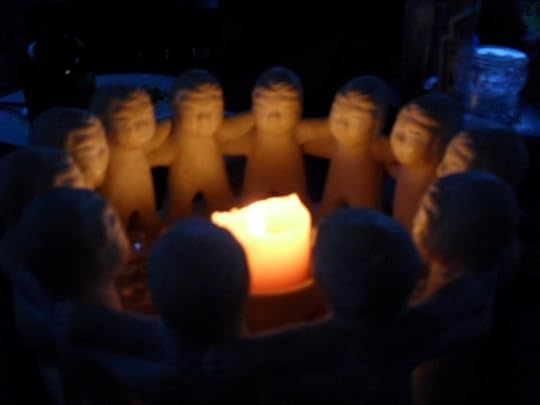
We all love to right, right? And it can be painful to be wrong, humiliating even? Righteousness compels us to stand up for what we believe in and is associated with being courageous. See Martin Luther King Jnr.
“The ultimate measure of a man is not where he stands in moments of comfort and convenience but where he stands at times of challenge and controversy.”
Martin Luther King Jnr.
Or John Paul Mellencamp,
“If we don’t stand for something, we’ll fall for anything.”
Or JFK,
“Let the word go forth… let every nation know whether it wishes us well or ill, that we shall pay any price… to ensure the survival of liberty.”
John F. Kennedy, 26th January 1961
Or Robert Kennedy (1966),
“Each time a man stands up for an ideal,
or acts to improve the lot of others,
or strikes out against injustice,
he sends forth a tiny ripple of hope
and crossing each other from a million
different centres of energy and daring,
those ripples build a current that can
sweep down the mightiest walls of
oppression and resistance.”
But is there a difference between being courageous and standing up for what you believe in and being so pig headed and self-righteous that you are willing to violate the very values you ‘say’ you believe in just to prove a point – or in simple speak – to cut off your nose despite your face?
There’s a few things in play here – firstly there are Values – Values are the things that you believe in that give meaning to life, things like freedom, truth, fairness, equality. The thing about Values is that we aspire to live them but most often we fail to actually deliver. For example, most of us would aspire to live by the Value of honesty but most – if not all - of us have told a lie. So, our Values live in the future as aspirational states of being.
Then there are beliefs about how you think the world works, what is right and wrong, and the way things actually are. These tend to be absolutist things like – either you believe in God or you don’t.
Then there are stories about who we think we are and how we describe the world to ourselves – especially the past – because we need to be able to make sense of what has happened in the past to be able to reconcile our current reality. The who we think we are part is bound up in what’s called ‘Self Identity Theory’ and part of this is our ‘Moral Self Identity’ – in other words how we see ourselves as a good or a bad person. For example a priest is likely to see themselves as a good moral person whereas a thief is likely to see themselves as a bad person.
Now the tricky bit is how these three things mix together – Aspirational Values, Beliefs and Stories.
You’d think that someone with a high Moral Self Identity would be least likely to do bad things but you might be surprised to know that the more tightly you are attached to your Moral Self Identity – the more likely you are to be self-righteous and the more likely you are to use justifications that enable you to do bad things without having to reassess your own view of yourself as a good person – oops…
Check out the graph below
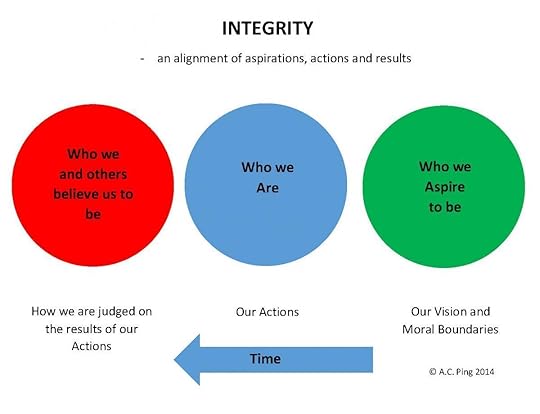
You see aspirations live in the Future, stories and who we believe we are live in the Past. Someone who has a strongly held view of who they are will fight to defend that view by telling a supportive story that leaves them in the position of being RIGHT – hence self-righteousness.
Complicated huh? What makes it even more complicated is that we have an inherent self-serving bias which leads us to perceptual blindness – in other words we see what we wish to see in order to support our fixed view of the World.
A ‘supportive story’ then won’t be based on all the facts, it will be based on a selective view of the World and will justify why the action needed to be taken and why it is fair. Some moral justifications for doing things however, actually neutralise the very Values that we say we aspire to up hold. There are seven common ones:-
- It’s not my responsibility (e.g. Nazi Germany “I was just following orders”)
- It’s not hurting anyone (e.g. Graffiti)
- They deserved it (e.g. Israel v Palestine)
- Condemning the condemners (e.g. “If you think I’m bad you should see them”)
- Appeal to higher loyalties (e.g. I did it for Family, Country, God…)
- Everyone else is doing it so I had no choice (e.g. bribes in developing countries)
- I deserve it (e.g. “I’ve worked back for the last two weeks so I deserve to take whatever stationary I want”)
Now this article is about Self Righteousness so let’s put it all into perspective – the more attached you are to being RIGHT, the more willing you will be to use these justifications which neutralise morals, to ensure that at least in your own mind (and maybe to your supporters) you remain RIGHT.
Good for you :)
However, in your determination to be RIGHT you may have violated the very Values that you aspire to uphold and in doing so have well and truly trapped yourself in the Past and closed the door to creating the possible Future you want – go figure? – and all because you are determined to be RIGHT…
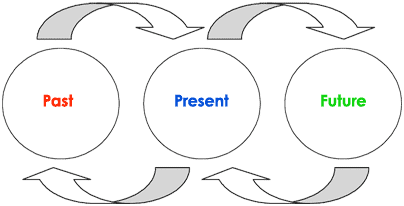
Right/Wrong thinking traps us in the Past and holds us in an ever spiralling cycle of ego based conflict.
If you find yourself in this cycle try reframing by asking better questions – What is it that you actually want? What do you need to do to create this? What do you need to let go of to allow you to move forwards?
Most importantly – as hard as it may be sometimes it’s incredibly empowering to be able to simply say “I’m sorry”.
In peace and love always.
September 18, 2014
These Things Are Sent To Test Us

"…there is nothing either good or bad but thinking makes it so.”
Hamlet, Act 2, Scene 2, William Shakespeare
The young man had been having a bad morning, a night of sleep plagued by disturbing dreams had morphed into a foul mood made all the worse by emotional hypersensitivity. Arriving at his favourite café with plans for some ‘me’ time to reset his jangled state his hopes were soon dashed by the persistent, and truly poor, harmonica playing of a beggar.
Resisting the temptation to have a monumental and very public emotional outburst he reluctantly gave up on his plans and climbed back onto his bike for the ride home. Channelling his frustrations into the pedals he powered along the path through the park weaving in and out of the pedestrians. Out of the corner of his eye a man stepped onto the path from the car park and it was only a reflex flick of the handlebars that saved them from colliding.
“Hey slow down”, said the old man.
Without thinking, and charged by the emotions of the mornings events, the young man lashed out, “F@ck you!”, he yelled.
Turning to see the effects of his outburst, the young man was shocked to stare straight into the bright eyes of the mystical old man he had met before. It was as if time stood still, one part of him wanted to tuck his tail between his legs and scurry away as fast as possible, pretending all the while, like a naughty school boy, that it just hadn’t happened. Another part, a grown up part, slammed on the brakes and turned the bike around.
The old man stood waiting for him as if he knew all along that there was no choice but for him to come back.
“I… I… I’m sorry”, stammered the young man, “I’m having a bad day, I…”
The old man held up his hands to silence him, “These things are sent to test us”, he said simply.
A wave of peace flowed over the young man. The mere presence of the old man and his simple acceptance of his foul outburst caused the dark cloud that had shadowed him to evaporate instantaneously.
“I’m sorry”, the young man started again, “there was a harmonica player at the café who…”
The old man chuckled, “Don’t blame anyone unless you want to be the victim. Do you want to be a victim?” he asked rhetorically, “Of course not!”. He chuckled louder amused by his own observation.
“Life goes in cycles. Some days are good, some days are bad, some times are hard, some times are easy, it’s not linear, it’s not predictable – otherwise it would be boring!” he laughed again, “What good would it be if life were predictable? How would you grow if you had no challenges in your life?”
The emotion welled up again in the young man, “Yes I know, I know, but I’ve been having a bad day! I didn’t sleep well and then the stupid beggar…”
The old man cut him off, his levity had vanished replaced by a tone as sharp as a razor, “But is that how you want to be?”
“It’s the best I can do!”, the young man replied.
“Is it?”, the old man asked sharply.
The two glared at each other, like an old and a young bull. At any moment it seemed the young man’s emotions would get the better of him but at the same time the intensity of the old man’s stare – his pure will – held the situation in check.
“It is really?” he asked again “Is it really the best you can do? We are limited only by our beliefs. If you believe that’s your best then it will be. So tell me again – is it really the best you can do?”
Time froze as the emotion swirled about them. Slowly the energy dissipated and the young man broke from the old man’s glare. He hung his head in shame.
“No”, he finally admitted.
“Good, good, good”, the old man clapped his hands, “First step accomplished!
Now next step – stop beating yourself up! Lift your head up high! Accept your failures and choose to love and accept yourself unconditionally. Take responsibility for your actions and do something about it!”
The breath flowed back into the young man. He straightened up, stood tall and looked directly into the old man’s eyes.
“I’m sorry, please forgive me”
The old man hugged him, and as he did he chuckled again, “It doesn’t take much to push you over the edge does it? Instead of reacting, use these things to strengthen your Will. They are sent to us for a reason – they are sent to test us. Seize the opportunity. The easy way is to react and to make excuses for why you aren’t being who you really want to be. It’s not your fault, you didn’t get enough sleep, you had a bad childhood, you deserve it, they deserve it, it’s not hurting anyone, everyone else is doing it so you have no choice, blah, blah, blah, blah, blah…
These are just words! Real growth, real life, comes when you stop making excuses and ask instead – what do I really want? and how do I need to be to have that?
When you get to that point, then you have the opportunity to claim your freedom by choosing how you want to be.”
In peace and love always.
September 10, 2014
Vision Quest Time

Coming into the Equinox - Sept 23rd - is traditionally the time of the year to refresh and renew your Vision this is because the energies of the cosmos are in equal balance - equal day equal night - hence equinox.
If you are in the Southern Hemisphere you are about to go into a period of about three months through to the summer solstice where the days are getting longer and longer. This means that the expansive energy of the sun is getting greater and greater. If you are in the Northern Hemisphere the opposite is occurring with the introspective energy of the Moon getting stronger and stronger up until the winter solstice.
This has implications for visioning - if you are entering an expansive period you need you be more orientated to DOing and getting stuff out there. If you are entering the introspective phase you need to be more orientated to BEing and getting your internal house in order.
Having said all that the question is how to do it...
Traditionally and ideally you should do some prep work over the next two weeks or so and then take yourself off to the mountains and sit in circle for up to 4 days and ask for spiritual guidance for your Vision. This can be hard to do if you live in a city and/or have ongoing commitments, however you can do the prep work and plant some seeds.
As a possibility I suggest this 11 day program.
For two days each consider the 5 areas of Vision in this order - Spiritual, Emotional, Physical, Mental, Material.
On the first day (Fri 12th Sept) ask the questions - what do I want and what does this look like and feel like? I'd suggest focusing on a one year time frame - so for example - sit quietly and imagine it's Sept 2015 - what do you want spiritually? what does this look like? that is - what are you actually DOing? and what does this feel like? remember here to focus on essence not form. Play with it here - put the question out there and allow it to come to you - be receptive in the dreams and in your everyday life. Use what you need to make it real - write, draw, paint etc
On the second day - ask - what do I need to let go of to allow this to happen? Write these answers on separate pieces of paper (you'll see why in a sec).
Then on day 3 & 4 (14th and 15th) you'd do the same with Emotional, 5 & 6 (16th & 17th) Physical (18th & 19th) Mental and so on until on the 21st Sept you will be finishing Material. Also if you are inspired to incorporate directions - this relates to the Medicine Wheel - you will be going East (Spirit), South (Emotional), West (Physical), North (Mental), Earth (Material).
Day 11 (22nd Sept) is the day to bring it all together and return to Spirit (East) to receive the new. Start by putting all your Visioning bits together - again allow yourself to synthesize the bits into a whole.
Next take all the bits of paper on which you have written all of the things you wish to let go of. Light a fire - or if not possible a candle (remember to unplug the smoke alarms...) - take each piece of paper in the order you wrote them - read them out loud and say "I release this past behaviour/pain/fear/memory/relationship (which ever is appropriate) to the universe and allow the energy to be transformed for the highest good" - then burn them.
Last bit - on the day of the Equinox - if you can go and sit somewhere quiet or take time out in some way that's great - if not light a candle and put some of your favourite things/crystals/photos (esp. of ancestors). Put your consolidated Visioning writings/drawings/paintings etc with your candle - if it is in a book make sure it is open - and ask for assistance and guidance to bring it into creation. Big key here is to be open - don't assume you know - allow intuition, spirit, prayer, insight to guide and inform you. Hold your intention to stay in that space for the whole day - be aware of nature, especially animals, birds etc. Take special note of your dreams that night.
On awakening say thank you remembering that Grace is the unearned love of God (Universal Spirit)
In peace and love always :)
More on the Facebook page www.facebook.com/a.c.pingpage
August 14, 2014
The 'How to' of Being Happy

"The problem of determining surely and universally which action would promote happiness of a rational being is completely insoluble… happiness is not an ideal of reason but of the imagination.”
Immanuel Kant
If you’ve ever studied ethics in any form you have most likely come up against Immanuel Kant, German Philosopher and key figure in the creation of Universalist ethical thinking and author of the dreaded ‘categorical imperative’…
Kant would have us believe, as noted above, that the application of the rational mind to the pursuit of happiness is a futile exercise due to the irrational nature of happiness. Duly noted… but are there some things that we can ‘do’ to help us release the magical Genie out of the bottle and help us on our way to happiness?
This is not a be all and end all post on happiness – many books and theses have been written on the subject – rather it’s an observation from someone who has struggled with happiness and seen others struggle, sometimes to the point of despair…
So, let’s call it a sharing of experiences.
So, first up I’d point out that it’s a holistic systemic issue – you can’t deal with one bit in isolation, you need to address the whole. By whole I mean all the parts of what it is to be human – physical, mental, emotional, material, spiritual.
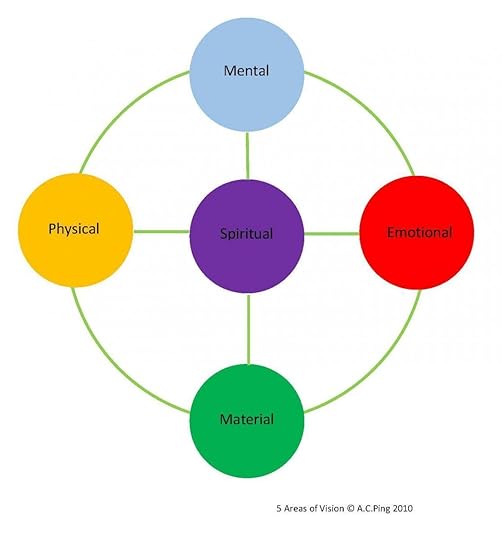
In the diagram you will see that everything effects everything else so the first thing you need to do once you’ve decided that you are going to have a crack at this happiness thing is define it – what are you actually trying to create?, what does good look like?, what would it look like if you were actually happy?
Let’s hear from Kant again,
“The concept of happiness is such an indeterminate concept, that, although every human being wishes to attain this, he can still never say determinately and consistently with himself what he really wishes and wills.”
Immanuel Kant
Oh…
Ok so first up – get with the program – everything changes… what you really want and need and wish for will change throughout the course of your life so you won’t answer this question once you will answer it over and over again. But, you can do some work on essence rather than form.
For example – physical – essence can be “I want to feel comfortable about my physical form. Be pleased with who I am and have enough energy and well-being to do what I wish to do.”
Note that this is very different to – form – “I want to be 65kg, have a body fat percentage of 12% and be able to fit into size 10 clothing…”
Essence means go for the feeling not the form. Feeling is about energy – you can’t see feelings, you feel them – yeah I know derr it’s obvious right but how often do we feel unhappy and then try to work it out by engaging the rational mind?
Physical effects all of the other parts of self.
Physical exercise is shown in studies to have a positive effect on well-being and happiness pretty much on par with drug type therapies (you can Google the research).
Here’s a picture to demonstrate
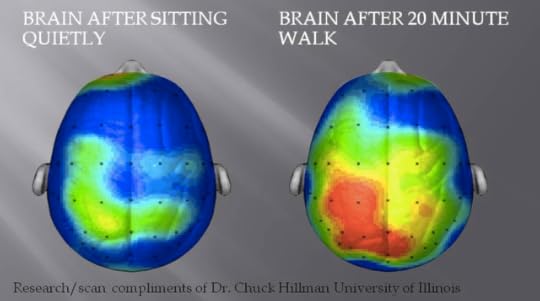
Want to be happy? Exercise or at least move.
Physical issues also affect happiness through other pathways.
• Food allergies – affect mood (http://extrahappiness.com/happiness/?p=1948)
• Different foods can lift your mood – see the article by Sandra Dubs http://www.ozfoodtrainer.com/index.php/what-s-hot/16-food-to-lift-your-mood
• Parasites – google parasites and happiness and you will see the link between the two and possibly get paranoid about the little critters crawling around inside of you…
• Places – see “How room designs effect your work and mood” http://www.scientificamerican.com/article/building-around-the-mind/
A commitment to happiness means a commitment to action – little things accumulate – little things means little habits – for instance something as simple as avoiding chocolate donuts if you work out after years and years (like I did) that even though they taste great as they go down, a little while later their gift is a deeply negative mood…
The key process here is:-
1. What do you want? What does good look like and feel like?
2. Self assess – where are you at out of 10?
3. Are you doing anything that’s undermining your own happiness? e.g. eating the wrong foods? Feeding your parasites? Allowing yourself to be in physical environments that don’t serve you?
4. What little things do you need to habitually DO to BE who you want to BE? e.g. daily yoga, walk, bike ride etc
Let’s move on to mental.
Physical effects mental remember so if you’re feeling down and out and unmotivated a good starting point is often the physical side of life. Once you’ve moved and got the brain engaged then it’s a good time to address the mental side.
The mental side comes down to an enduring battle between the rational mind and its self-appointed role as commander and chief, and the intuitive, sensing part of the brain. A lot of the ‘to do’ part of happiness comes down to training the brain in little habitual processes that will allow it to self-manage.
See Daniel Kahneman’s TED talk “The riddle of experience vs memory” http://www.ted.com/talks/daniel_kahneman_the_riddle_of_experience_vs_memory
Bottom line is – you can have great happy experiences but if the remembering self chooses not to remember these experiences then you will be an unhappy person. Your task is to direct your attention.
So – trick #1 – teach the brain to habitually remember the good experiences – every day at the end of the day ask yourself “What did I do right today?” and/or “What am I happy about today and what am I grateful for?”
And/or write the answers down in a journal – the physical act of writing these things down will assist in reinforcing your happy story.
Martin Seligman has spent a lifetime studying optimism, pessimism and happiness – see his website “Authentic Happiness” https://www.authentichappiness.sas.upenn.edu/
One of the keys to Seligman’s work is the difference between how an optimistic person and a pessimistic person describes events to themselves. This is what I refer to as internal dialogue. The distinctions Seligman uses are: - Personal/Impersonal, Temporary/Permanent, Specific/Pervasive.
If a bad thing happens an optimist will describe the event as Impersonal, Temporary and Specific e.g. “I just got the sack but it’s not about me it’s a corporate downsizing, it’s just a one of temporary setback and I will be back on my feet in no time”.
A pessimist might describe the same situation as Personal, Permanent and Pervasive. “I just got the sack. It’s all my fault, bad things are always happening to me and I will never get back on my feet again.”
A bit dramatic I know but do you get the picture?
So, what to do?
• #1 habitually direct your attention to remembering the good stuff
• #2 monitor your internal dialogue and check how you are describing experiences to yourself
• #3 change your life narrative by asking empowering questions that direct your attention to the positive e.g. “Why am I so blessed?”
Which brings us to Emotional.
Emotional well-being is about FEELING and then CHOOSING. Repressing feelings won’t help just as being overwhelmed by feelings won’t help. Choose to feel and then choose what to do about those feelings.
See the work of Candace Pert and specifically “Your body is your subconscious mind” http://candacepert.com/ . Candace Pert’s work focusses on the relationship between the mind and mood, and the chemical changes in the body. She was a great proponent of body work and the ability to shift emotional blocks through body work – for instance massage and other body work modalities.
Knowing what you are aiming for again is key – what does good look like? e.g. “I am fully emotionally expressive. I feel deeply and then choose what to do with those feelings. I honour my own personal space and feel loved and appreciated by my friends and family.”
Training your body to know what this feels like is a good start. I recommend an exercise called “Creating a Circle of Honour” http://www.acping.net/catalyser/creating-circle-honour
Deciding to take responsibility for your mood is a good one to get as well – see “Who decides what mood you’re in” http://www.acping.net/catalyser/who-decides-what-mood-youre
Knowing what good habits will support your emotional well-being is also critical – for example if you want to have good relationships with people it takes time – quality time – so ask yourself questions like “If I am going to be clear and connected with my family what do I need to DO habitually to make this happen?” e.g. weekly dinners out with your partner, picking up the kids from school occasionally if you are the parent who usually does not do this, scheduling regular family holidays, and making sure you have one on one time with kids, friends and partners as needed.
Again though – if you don’t know what good looks like you’ll find it hard to DO stuff regularly that delivers this – you may instead end up simply being reactive to life events.
Material stuff dominates our capitalist world. Many people focus exclusively on the material when they do goal setting and the like – but is this what you really want? Sure I’d like a huge warehouse full of classic cars, a massive house, even a yacht would be cool but if it means that the entire time I’m stressing about my things and worrying then am I truly rich or do I have a poor mentality? Money ranks right up there as a source of unhappiness and relationship conflict.
The research on this is interesting, essentially it says that up to a certain point – about $60k per annum if you’re in the USA – there is a correlation between happiness and material wealth. However, over that the correlation falls apart and of course, like many statistics, it’s a gross generalisation as I’m sure many of you know people who are rich who are poor in spirit and many who are poor but rich in spirit. When looking at the Happy Planet Index http://www.happyplanetindex.org/ Costa Rica ranks #1.
Again it is essence that is key. Maybe good looks like “I am comfortable, relaxed and grateful for all of the things that I have. I allow the flow of abundance in my life and trust that what I am getting now is perfect.”
You’re probably starting to see the interconnectedness between all these aspects of self so it should come as no surprise that Spirit sits right in the middle of the picture.
Spirituality – people can get really reactive when others start talking about spirituality – many confuse spirituality with religion and if you’re like me it may have negative associations with memories of Sunday school, prayer and the whole idea of a dominant patriarchal figure looking down from above…
The best way of describing the distinction that I’ve found is that religion is about answers (of what’s right and wrong e.g. the Ten Commandments) and spirituality is about questions.
For me, spirituality is simply about acknowledging a connection with the unseen aspects of life. Some, like my Dad, do this by pursuits such as fishing. Others like a walk on the beach with the dog at sunset, others meditate, pray, do yoga, Zen breathing, the list goes on. The point is that at our core we humans have a need to connect with something bigger than ourselves. Fundamentally, we need to have faith that there is more to life than we can actually see and that there is divine justice in the world. A spiritual practice feeds this and sustains us when things don’t go the way we want them to.
Peace – deep inner peace is what you’re looking for here. A practice that enables you to let go of any worries about the past or the future and simply be present in a simple open hearted way.
The doing part of this is finding something that resonates with you and enables you to get to that place. Exploration of the possibilities is key.
So, there you go, hope some of this is useful – and again – this is not a cure all, end all post but rather a share of some of the things that have worked for me.
“Often people attempt to live their lives backwards; they try to have more things, or more money, in order to do more of what they want, so they will be happier. The way it actually works is in reverse. You must first be who you really are, then do what you need to do, in order to have what you want.”
Margaret Young
In peace and love always.



